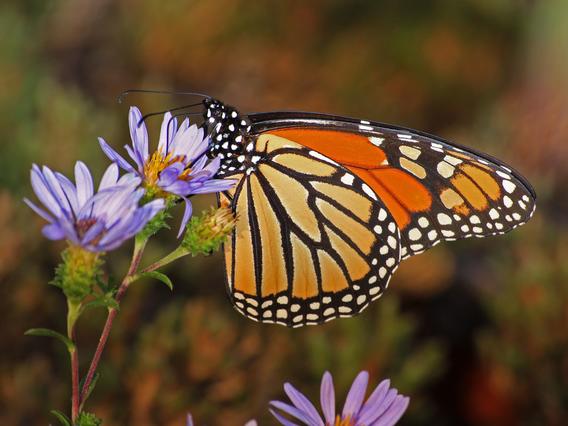
Insects provide essential ecosystem services such as food, cultural, and aesthetic resources.
Challenge: Climate change, habitat loss, pollution, invasive species, and overexploitation causes widespread declines in butterfly populations; relative contributions are poorly understood, and this limits management efforts
Principal Investigator(s):
- Elise Zipkin (Michigan State University)
- Leslie Ries (Georgetown University)
Cooperator/Partner(s):
- Wayne Thogmartin (U.S. Geological Survey)
- Ryan Drum (U.S. Fish and Wildlife Service)
- Kelly Nail (U.S. Fish and Wildlife Service)
- Toni Lyn Morelli (U.S. Geological Survey)
Global concern of an “insect apocalypse” is fueling demand for large-scale, long-term studies of insect population dynamics. Butterflies associated with open habitat, like prairies and grasslands, have long been identified as species of concern in the Midwest. The iconic monarch butterfly, which serves as a flagship for both migration and insect conservation, is one such species of conservation concern and is currently under consideration for federal listing under the Endangered Species Act. Recent analyses suggest that common, widespread species may also be declining. Yet robust evidence for general declines is patchy and the causes are difficult to discern. Understanding the relative importance of climate, land use, and agricultural practices is critical to inform conservation and management efforts for species of conservation concern. A broad framework is needed to identify species as potential targets for future conservation.
The Midwestern U.S. has the highest density of structured butterfly monitoring programs compared to anywhere else in North America, providing large quantities of high-quality data. The research team will combine 30 years of butterfly data with data on land-use and climate to rigorously establish and understand region-wide trends and quantify the degree to which climate is contributing to current butterfly declines in the Midwest. The team will also develop methods to integrate structured monitoring data with “opportunistic” sightings of butterflies from online citizen-science databases, develop models to estimate status and trends of monarch butterflies as well as other butterfly species across the Midwest, identify environmental drivers of change, and project climate variables into the future and assess how populations may respond to changes in temperature. This work will elucidate the role of climate in butterfly declines in the Midwest and help resource managers identify and prioritize conservation actions as well as candidate species for potential listing under the Endangered Species Act.
Read more from the CASC Project Explorer.
Related Publications
Multi-season climate projections forecast declines in migratory monarch butterflies Zylstra et al. 2022; Global Change Biology
